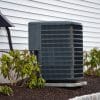Dealing with an air conditioner that isn’t blowing cold air can be frustrating, especially during hot weather. Several factors can contribute to this issue, and understanding the potential causes can help you troubleshoot and resolve the problem efficiently.
Here’s a comprehensive guide from Orzech Heating & Cooling to help you identify and fix the common reasons why your AC might not be blowing cold air.
Common Reasons Your AC Is Not Blowing Cold Air
1. Dirty Air Filters
Air filters play a crucial role in your air conditioning system by trapping dust, dirt, and other particles, ensuring clean air circulation. Over time, these filters can become clogged, restricting airflow and reducing the system’s cooling efficiency. Signs of a dirty filter include reduced airflow, increased dust around the home, and a higher energy bill. To fix this, check your air filters regularly and clean or replace them as needed.
2. Thermostat Issues
The thermostat controls the temperature setting of your AC unit. If it’s not set correctly or is malfunctioning, your air conditioner won’t cool properly. First, ensure that the thermostat is set to “cool” mode and the temperature is set lower than the current room temperature. If the settings are correct but the air conditioner still isn’t cooling, try recalibrating the thermostat or replacing the batteries. If problems persist, consider replacing the thermostat, especially if it’s outdated.
3. Refrigerant Leaks
Refrigerant is essential for the cooling process in an AC unit. A leak can significantly reduce the system’s ability to cool your home. Common signs of a refrigerant leak include hissing noises, ice buildup on the refrigerant line, and a noticeable decrease in cooling efficiency. If you suspect a refrigerant leak, it’s crucial to call a professional HVAC technician to locate and repair the leak and recharge the system with the appropriate refrigerant.
4. Blocked or Dirty Condenser Coils
The condenser coils, located in the outdoor unit, release the heat removed from your home. If these coils are dirty or blocked, they can’t effectively release heat, which can hinder the cooling process. Common causes of dirty coils include dirt, debris, and grass clippings. To clean the condenser coils, turn off the power to the unit and gently clean the coils with a garden hose or a specialized coil cleaner. Regular maintenance can prevent this issue from recurring.
5. Frozen Evaporator Coils
The evaporator coils absorb heat from the air inside your home. If they freeze, they can’t do their job effectively, leading to warm air blowing from the air conditioner. Causes of frozen coils include low refrigerant levels, dirty air filters, and poor airflow. While homeowners can check for dirty filters, diagnosing low refrigerant levels and other complex issues should be left to a professional HVAC technician. This ensures that the underlying problems are correctly identified and safely resolved.
6. Electrical Issues
Diagnosing and fixing persistent electrical problems, such as frequent breaker trips or faulty wiring, can affect your AC unit’s performance. While homeowners can reset breakers and replace fuses, persistent electrical issues should be addressed by an electrician or HVAC technician to avoid safety hazards. Ensuring professional handling of these problems helps maintain system safety and functionality.
7. Fan Problems
The fan in your AC unit helps circulate air over the evaporator coils and throughout your home. If the fan isn’t working correctly, it can lead to inadequate cooling. Signs of fan issues include unusual noises, no airflow, or the fan not starting at all. To troubleshoot, turn off the power and inspect the fan motor and blades for obstructions or damage. If the fan motor is faulty, you may need to replace it. For such complex repairs, consider hiring a professional.
8. Ductwork Leaks or Blockages
Ductwork is responsible for distributing cool air throughout your home. Leaks or blockages in the ducts can lead to uneven cooling or no cooling at all. Inspect your ductwork for visible leaks or obstructions. Seal any leaks with duct tape or mastic sealant, and remove any blockages. Ensuring your ducts are clean and in good condition can significantly improve your AC’s performance.
DIY Troubleshooting Tips for AC Not Blowing Cold Air
When your air conditioner isn’t blowing cold air, you can take some basic steps to identify and possibly fix the problem. These steps can help you get your AC system back to properly cooling your home, ensuring relief from the summer heat.
Check and Replace Dirty Air Filters
A dirty air filter is one of the most common reasons why an air conditioner is not blowing air. Over time, air filters collect dust, dirt, and other airborne particles, which can restrict airflow and cause your AC unit to blow warm air. Locate the system’s air filter, usually near the indoor unit or in the return air duct, and inspect it for dirt. If it’s clogged, clean or replace it. Regularly replacing dirty filters every one to three months helps maintain air quality and keeps your air conditioner running efficiently.
Ensure the Thermostat Is Set Correctly
Incorrect thermostat settings can prevent your air conditioning unit from blowing cooled air. Ensure your thermostat is set to “cool” and the desired temperature setting is lower than the current room temperature. Verify that the thermostat is functioning properly and, if necessary, replace the batteries or recalibrate it. Proper thermostat settings are crucial for the central air conditioner to blow cold air effectively.
Inspect the Outdoor Unit for Debris and Clean the Condenser Coils
The outdoor unit of your central air conditioning system can become dirty or blocked, affecting its ability to cool properly. Turn off the power to the unit and check for debris like leaves, grass, and dirt around the unit. Clean the condenser coils by gently wiping them with a cloth or using a garden hose to spray off dirt. Ensuring the outdoor unit is free of debris allows it to draw in outdoor air effectively, contributing to the system blowing cool air.
Look for Ice Buildup on Evaporator Coils and Let It Thaw if Present
A frozen evaporator coil can prevent your AC from blowing cold air. If you notice frost buildup on the coils, turn off the HVAC system and let the ice thaw completely. Check for and replace any dirty filters, as restricted airflow can cause the coils to freeze. Ensuring proper airflow helps prevent ice buildup and allows the evaporator coil to cool the air efficiently.
Check the Circuit Breaker and Reset Any Tripped Breakers
Electrical issues can cause your air conditioner to stop cooling. Locate your home’s electrical panel and check for any tripped circuit breakers. Reset them by switching them off and then back on. If the breaker trips again, it may indicate a larger electrical problem that requires a professional HVAC technician.
Safety Precautions
When performing DIY maintenance on your central air conditioning unit, always prioritize safety. Turn off the power to the unit before inspecting or cleaning any components. Use proper tools and protective gear to avoid injury. Handling components carefully ensures that maintenance tasks are performed correctly and safely.
When to Call a Professional
While some issues can be resolved with DIY efforts, there are situations where professional help is necessary. Call a professional HVAC technician if:
- You suspect a refrigerant leak.
- The thermostat replacement doesn’t solve the problem.
- Electrical issues persist despite resetting breakers and replacing fuses.
- The fan motor is damaged or needs replacement.
- Ductwork problems are extensive or difficult to access.
Professional technicians have the tools and expertise to diagnose and fix complex AC problems efficiently.
Preventive Maintenance Tips
Regular maintenance is key to keeping your air conditioner running smoothly. Here are some tips:
- Change or clean air filters every 1-3 months.
- Schedule annual professional inspections and tune-ups.
- Keep the outdoor condenser unit free of debris and ensure proper airflow.
- Check and clean condenser and evaporator coils regularly.
- Inspect ductwork for leaks and blockages periodically.
By following these maintenance tips, you can extend the life of your AC unit and ensure it operates efficiently.
Conclusion
Understanding why your AC units might not be blowing cold air and knowing how to troubleshoot common issues can save you time and money. Regular maintenance and timely professional AC repair are essential to keep your cooling system in top shape.
We hope this article has helped you answer the question: “Why is my AC not blowing cold air?”.
FAQs
1. Why is my AC blowing warm air instead of cold air?
Your AC could be blowing warm air due to a dirty coil, low refrigerant level, or thermostat issues. Ensure your thermostat is set correctly and check for any dirty or clogged filters.
2. How can indoor air quality affect my AC’s performance?
Poor indoor air quality, often caused by clogged filters and indoor pets, can restrict airflow, making it difficult for your AC to cool properly. Regularly replacing filters can help maintain good air quality.
3. When should I call an HVAC professional?
If your air conditioner is blowing hot air or if you suspect refrigerant leaks, it’s best to call an HVAC professional. They can accurately diagnose and fix issues that you may not be able to handle on your own.
4. What should I do if my AC’s refrigerant lines are frozen?
Turn off the AC and let the ice thaw completely. Check for and replace any clogged filters, and ensure there are no airflow obstructions. If the problem persists, contact a technician to check the refrigerant level and system for leaks.
5. Can a clogged drain affect my air conditioners?
Yes, a clogged drain can lead to water buildup and damage your AC units. Regularly check and clean the drainage pipe to prevent clogs and ensure proper functioning.






